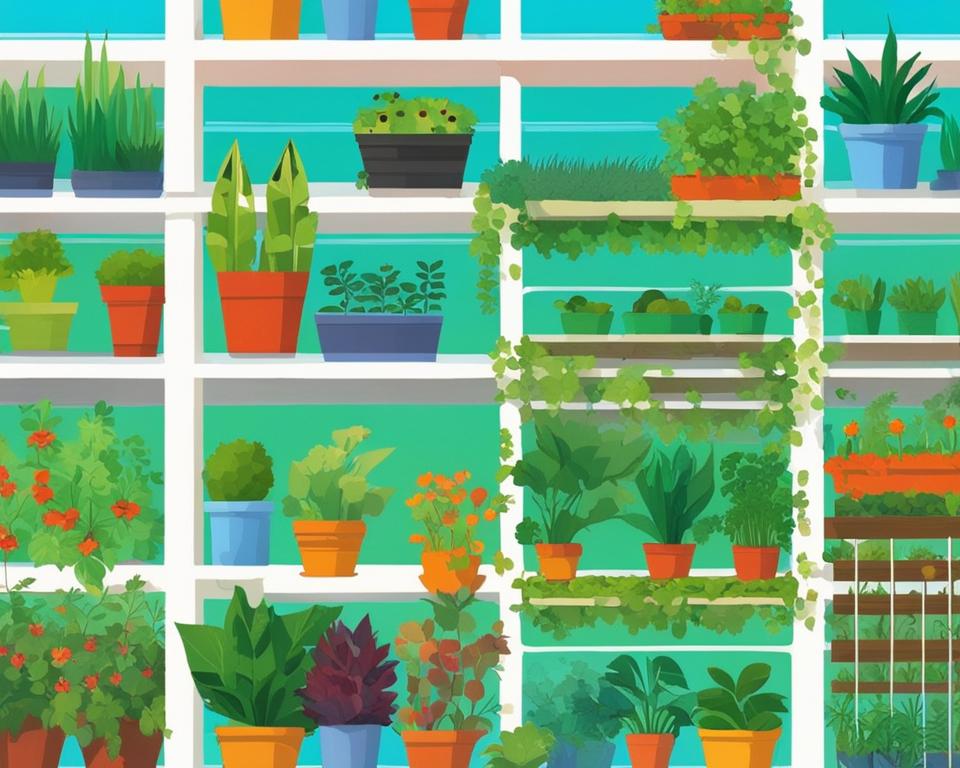Are you intrigued by the concept of vertical gardening but not sure how to begin? Vertical gardening made simple is just a matter of understanding the basics and applying some creativity. Whether you have a sprawling backyard or just a cozy balcony, this guide will show you how to make vertical gardening a reality. By growing upwards instead of outwards, you can enjoy an abundant garden that’s both easy to maintain and a delight to behold. Embrace the upward growth of plants and discover how vertical gardens can transform even the smallest of spaces into lush, productive green havens.
Not only do vertical gardens save valuable ground space, but they also bring your fruits and vegetables closer, which makes harvesting a breeze — no extensive kneeling or scouring through foliage necessary. Whether you’re looking to grow ornamental plants to enhance the beauty of your home or hearty vegetables for your table, vertical gardens offer a functional and inviting outdoor aesthetic. Follow along for the essential steps to creating your own vibrant vertical garden.
Key Takeaways
- Vertical gardens maximize limited space and can be crafted in any size area.
- Upward plant growth simplifies harvesting and fosters a back-friendly gardening experience.
- Learning how to make vertical gardening can involve DIY approaches, utilizing various support structures like trellises.
- Vertical gardens improve air circulation around plants, promoting healthier growth.
- A mix of ornamental and functional plants in a vertical garden can offer both aesthetic pleasure and practical benefits.
- With the right steps, vertical gardening can be made simple, adding a new dimension to your gardening experience.
Understanding Vertical Gardening and Its Benefits
As urban spaces become more cramped and the need for greenery grows, vertical gardening surfaces as an innovative solution. This method of gardening allows city dwellers and those with limited ground space to cultivate an array of plants, from leafy greens to ornamental flowers, by taking advantage of the vertical plane.
What is Vertical Gardening?
At its core, vertical gardening is about transforming the orientation of horticulture from horizontal to vertical, utilizing vertical gardening systems such as trellises, wall planters, and stacked containers. This approach does more than just save space; it opens up a new realm of gardening possibilities, allowing you to explore a variety of plants in a range of urban settings.
Space Efficiency and Aesthetics
One of the primary vertical gardening benefits is its space efficiency. In dense urban environments, square footage is at a premium. Vertical gardens introduce a clever use of vertical space, fostering plant life in areas that might otherwise remain barren and grey. The added layer of living greenery brings a touch of nature’s splendor to concrete jungles, enhancing your living space with the simple beauty of verdant growth.
Healthier Plants and Convenient Harvesting
The elevation of plants off the ground results in a multitude of advantages for plant health. With better air circulation and reduced contact with soil-borne diseases, the plants thrive. Additionally, the ease of harvest is markedly improved—no more bending over or struggling in awkward positions. Instead, everything you need is within a comfortable reach.
Environmental Impact and Sustainability
Vertical gardens are more than just a stylish trend; they carry significant environmental implications. By improving air quality and contributing to urban cooling, these dynamic gardens play a role in building a more sustainable future. Not only do they lend themselves to increased biodiversity within cities, but they also offer opportunities for recycling water through innovative irrigation systems.
- Improved biodiversity in urban areas
- Reduction in urban heat islands
- Opportunities for sustainable water usage
In summary, vertical gardening expands horticultural horizons, promotes environmental sustainability, and revitalizes your living space with style and functionality. Whether it’s the allure of a lush green wall or the practicality of growing herbs for your kitchen, the benefits of a vertical garden are waiting to be reaped.
Planning Your DIY Vertical Garden
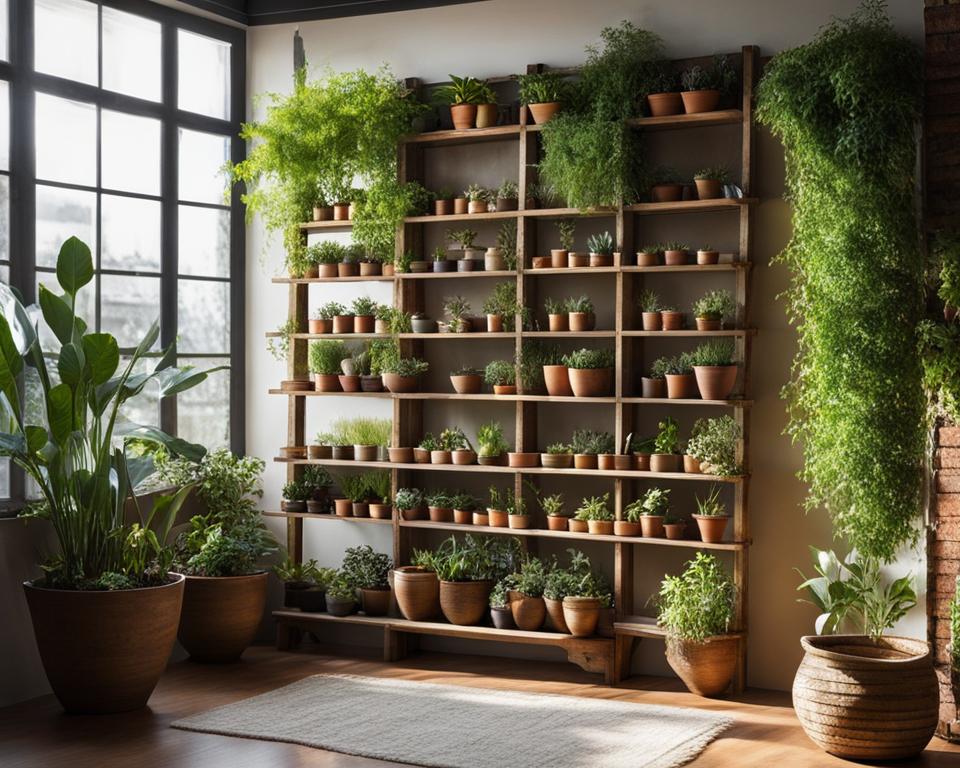
For the city dwellers and homeowners with limited space, DIY vertical gardening can transform a tiny patch into a lush, vertical oasis. The adventure of crafting your vertical garden begins with thoughtful planning to ensure a successful harvest and a beautiful green space. Let’s delve into the initial steps to create your own high-rise horticulture.
Assessing Your Space and Conditions
Before you start, evaluating the characteristics of your space lays the foundation for your vertical garden. Consider the direction your garden faces and the amount of sunlight it receives throughout the day. For condo balconies or modest backyards, maximizing what you have is crucial. Take note of the soil quality; is it suitable for the plants you wish to grow, or will you need to bring in a healthier medium? By acknowledging these conditions, you’re setting up your garden—and yourself—for success.
Selecting Suitable Plants for Your Garden
The plants you choose play a pivotal role in your garden’s productivity. Opt for species that thrive in your assessed conditions. Climbing varieties like tomatoes, beans, and peas are staples in vertical gardening for small spaces, while compact plants like herbs and salad greens fit nicely even when horizontal territory is scarce. Remember, vertical gardens can drain water differently, so pick plants that are forgiving or benefit from the unique watering conditions.
Vertical Gardening for Small Spaces: Making the Most out of Your Area
Small yards or balcony corners become prime real estate when you take your garden vertical. By utilizing vertical structures like trellises, hanging baskets, or even upcycled items like wooden pallets, you can significantly amplify your planting area. A compact 5-by-5-foot space can burgeon into a vertical plot ripe with your favorite fruits, vegetables, and flowers. With creativity and efficient use of vertical space, your garden will ascend to new heights of beauty and yield.
How to Make Vertical Gardening: Choosing the Right Structures
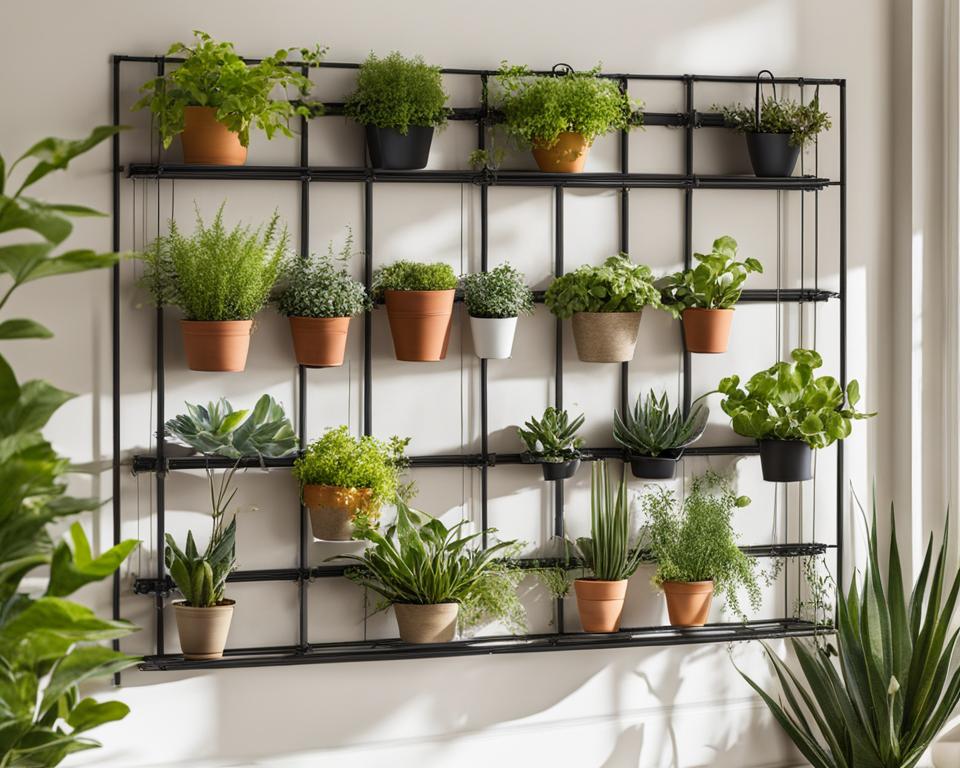
When it comes to vertical gardening design, the selection of support structures is as important as the plants themselves. The right framework sets the stage for your garden to thrive vertically. Whether you’re contemplating how to build a vertical garden structure for utility or decoration, it must integrate seamlessly with your available space and gardening aspirations.
Let’s explore the types of structures you can create or obtain to support your vertical garden:
- **Trellises:** Ideal for climbers like tomatoes and beans, they can be built with wood, metal, or even bamboo.
- **Wall Planters:** Utilize vertical space on walls or fences, perfect for herbs and small vegetables.
- **Garden Towers:** Suitable for those with limited ground space, integrating several layers of planters into one vertical element.
- **Hanging Baskets:** A simple and charming way to grow plants downwards, often used for flowers, strawberries, or trailing tomatoes.
Incorporating DIY elements not only adds uniqueness to your vertical gardening design but also helps to keep costs down. Imagine transforming a pallet into a living wall of green, or a neglected ladder into a cascading plant feature.
To further delve into the options for your vertical garden, consider the following table, which compares different vertical support structures:
| Structure Type | Pros | Cons | Best For |
|---|---|---|---|
| Freestanding Trellis | Easy to relocate, great for showcasing plants | May require additional support for stability | Climbing flowers, peas, and ivy |
| Wall-Mounted Planter | Saves space, immediate aesthetic impact | Limits plant size and root growth | Herbs, ferns, and small perennials |
| Arched Trellis | Beautiful design element, supports plant growth from multiple angles | Can be complex to construct | Grapes, roses, and squash |
| Vertical Pallet Garden | Recycles materials, offers multiple planting pockets | Requires lining and soil containment | Succulents, small flowers, and leafy greens |
Remember to take into account the weight of the plants and their growth habits when designing your vertical garden. Lightweight materials may not support heavier fruiting plants, while robust structures might be overkill for delicate ornamentals. Your vertical garden should be not only functional but a reflection of your creativity and love for gardening.
Building Your Vertical Gardening Systems
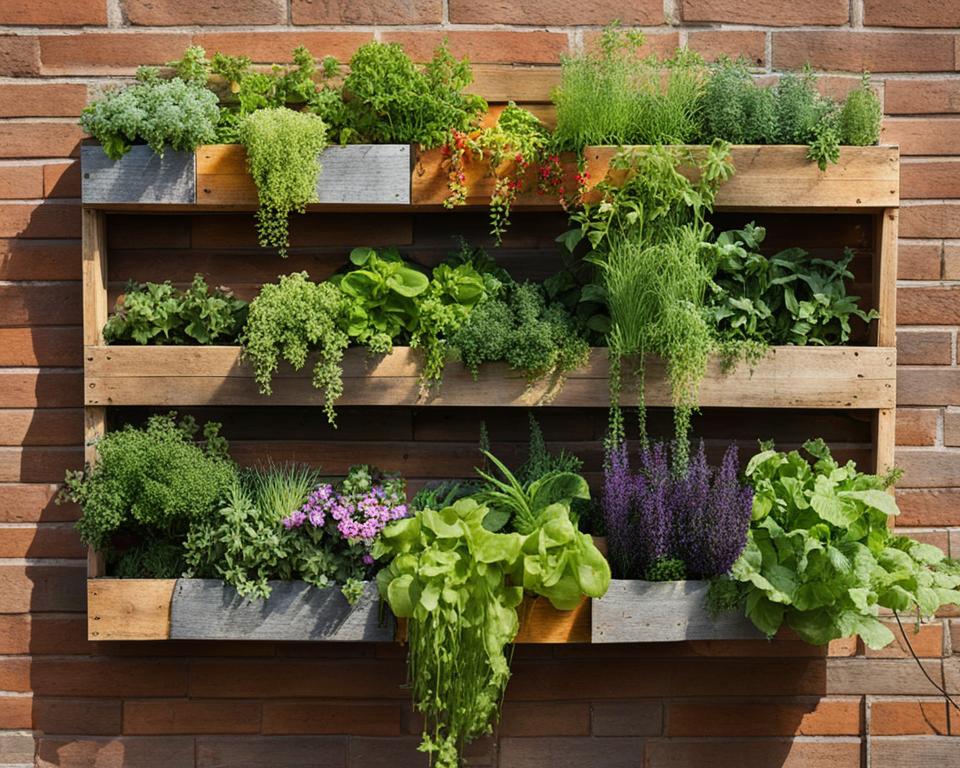
Embarking on your vertical gardening journey is not only about aesthetics; it’s a functional move towards a more productive use of space. With the rise of urban gardening and the need for efficient use of outdoor areas, your inclination towards DIY vertical gardening techniques is timely. These techniques empower you to construct robust structures that can transform your gardening experience, bringing lush greenery to your environment and fresh produce to your table.
DIY Arched Garden Trellises
Imagine a garden that arches gracefully towards the sky, supporting vibrant climbers and creating a stunning green canopy. The construction of DIY arched trellises helps achieve this vision, and it doesn’t demand great expertise. Use cattle panels and T-posts as your framework; these materials are sturdy and long-lasting, allowing you to weave an intricate web for your climbers to thrive. Furthermore, this structure is flexible, not only in form but also in function, capable of being installed in various garden spots.
Simple and Affordable Vertical Supports
For a more straightforward approach, vertical supports can be fashioned from bamboo stakes or PVC pipes. Erect a teepee or a simple grid and watch as your peas, beans, or even tomatoes clamber upwards with ease. This method is cost-effective, making vertical gardening more accessible to those on a budget or for beginners who wish to experiment before fully committing to more elaborate structures.
Upcycling Materials for Garden Structures
Upcycling is not merely a trend; it’s a sustainable approach to gardening that resonates with the eco-conscious grower. Your search for vertical gardening ideas may lead you to discover how old bed frames, wooden pallets, or even unused ladders can be converted into vertical gardening gold. These salvaged items can be given a second life, reinforcing your garden while reducing waste.
| Material | Recommended Plants | Advantages |
|---|---|---|
| Cattle Panels | Tomatoes, Cucumbers, Grapes | Durability and Suitable for Heavy Fruiting Plants |
| Bamboo Stakes | Peas, Beans, Morning Glories | Lightweight and Easily Configurable |
| Wooden Pallets | Herbs, Strawberries, Lettuces | Best for Small Plants and Urban Settings |
| Old Ladders | Potted Plants, Ivy, Sweet peas | Decorative and Space-Efficient |
As your vertical garden takes form, these DIY efforts deliver not just beauty or yields, but also the gratification of creating something functional and personal. Monitor your trellises for stability and be inspired to expand your garden upwards as you explore these vertical gardening ideas and techniques.
Cultivating a Garden That Grows Up and Over
Embracing vertical gardening plants is not just about saving space; it’s about creating a living tapestry on fences, walls, and trellises. The secret is to choose the right varieties that love to reach for the skies. Think of climbing beans, the twirling tendrils of peas, or the firm stalks of tomatoes. These plants are more than willing to grow vertically, provided they have the right support. Here’s a little inspiration and a few vertical gardening tips to guide your green thumb upwards.
As you start your vertical garden, consider the following list of plants that are particularly adept at vertical growing:
- Climbing beans – use poles or trellises for support
- Peas – perfect for cooler weather and can climb almost any structure
- Cucumbers – grow easily on a mesh support, producing fruits in abundance
- Melons – opt for smaller varieties and provide sturdy support
- Squash – enjoy vertical spaces and can flourish with proper scaffolding
- Tomatoes – with cages or trellises, they will rise with vigor
For those seeking structure and design inspiration, behold the table below:
| Plant Type | Structure Idea | Growth Tips |
|---|---|---|
| Climbing Beans | Bamboo Teepees | Plant at the base and train upwards |
| Peas | Chicken Wire Fencing | Provide initial guidance; they’ll clasp naturally |
| Cucumbers | Vertical Mesh | Use soft ties to secure vines as they grow |
| Melons | Horizontal Beams | Support fruit with slings as they develop |
| Squash | A-Frame Trellis | Direct the vines through and around the frame |
| Tomatoes | Cages and Stakes | Regular pruning helps manage growth |
The Best Plants for Your Vertical Garden
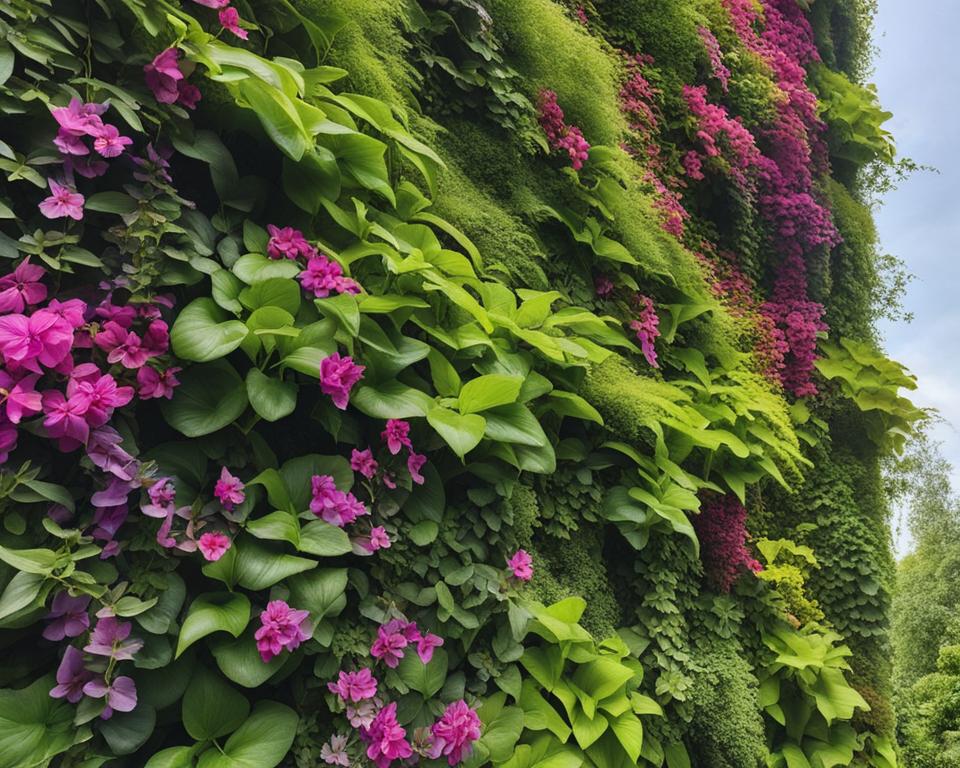
When you embark on the exciting journey of designing your own vertical garden, one of the most crucial decisions involves selecting the right vertical gardening plants. A well-planned vertical garden combines both utility and beauty, transforming any space into a lush, vertical ecosystem. Let’s explore some of the top plant choices that thrive in a vertical setting, offering not just an abundant harvest but also contributing to a breathtaking vertical gardening design.
Climbers and Trailing Plants
The backbone of any vertical garden, climbers and trailing plants have the natural ability to ascend, creating a living tapestry on trellises and walls. These species excel in their relentless climb towards light, making them ideal candidates for your vertical oasis.
- Ivy (Hedera)
- Climbing Hydrangea (Hydrangea petiolaris)
- Clematis
- Wisteria
- Morning Glory (Ipomoea)
Edible Plants That Thrive Vertically
A vertical garden can also be a source of your daily greens, herbs, and fruits. Some edible plants not only adapt well to vertical growth but also provide fresh produce right at your fingertips. Here are some delicious options:
| Edible Plant | Type of Support Needed | Light Requirement |
|---|---|---|
| Cucumbers (Cucumis sativus) | Trellis or Cages | Full Sun |
| Tomatoes (Solanum lycopersicum) | Stakes or Vertical Frames | Full Sun |
| Pole Beans (Phaseolus vulgaris) | Trellises or Netting | Full Sun to Partial Shade |
| Peas (Pisum sativum) | Supports or Chicken Wire | Full Sun to Partial Shade |
Ornamental Plants for Vertical Beauty
While edible plants feed the body, ornamental plants delight the senses. Including a variety of flowering plants can inject color and fragrance into your vertical garden, making it an attractive feature in your home or outdoor area.
- Bougainvillea
- Mandevilla
- Passion Flower (Passiflora)
- Black-eyed Susan Vine (Thunbergia alata)
Your vertical garden holds the potential to become an emblem of natural elegance and a testament to sustainable living. By harnessing the vertical plane, you maximize not only the beauty but also the bounty that your garden offers—a true symbiosis of form and function.
Vertical Gardening Techniques for Maximizing Yield

When exploring vertical gardening techniques, you’ll discover that the most beneficial practices are those targeting the efficient use of space and resources to maximize vertical garden yield. Proven methods include:
- Implementing companion planting to boost growth and deter pests
- Training plants to climb vertically, which promotes better air circulation and sunlight exposure
- Regular pruning to maintain plant health and direct energy to productive growth
These approaches necessitate a clear understanding of plant-specific requirements and a willingness to adjust techniques as plants grow. Next, we illustrate some of these techniques in a detailed table:
| Technique | Description | Benefits |
|---|---|---|
| Proper Spacing | Allocate space strategically between plants to prevent overcrowding. | Ensures adequate air flow and resource availability for each plant. |
| Companion Planting | Group plants with compatible growth habits and needs. | Increases yields, saves space, and prevents pest issues. |
| Vertical Training | Use stakes, cages, or trellises to guide the upward growth of plants. | Utilizes vertical space efficiently and improves plant health. |
| Regular Pruning | Trim to remove non-productive or excessive growth. | Focuses plant’s energy on fruiting and reduces disease risk. |
With the table above, you’re better equipped to visualize and execute plans that can lead to a flourishing vertical garden. Remember that vertical gardens are living entities; they require your attention and adaptation over time.
As an essential tip, always monitor the moisture levels and nutrient intake of your vertical garden since the vertical orientation can affect both. The end goal is to create a garden that’s not only visually striking but also rich in produce. Consistency in care and strategizing will reap rewards in the form of a bountiful yield. To conclude, the rewarding endeavor of vertical gardening is as much about the techniques applied as it is about your ongoing involvement and adaptation to your garden’s needs.
Ensuring Proper Drainage and Soil Quality
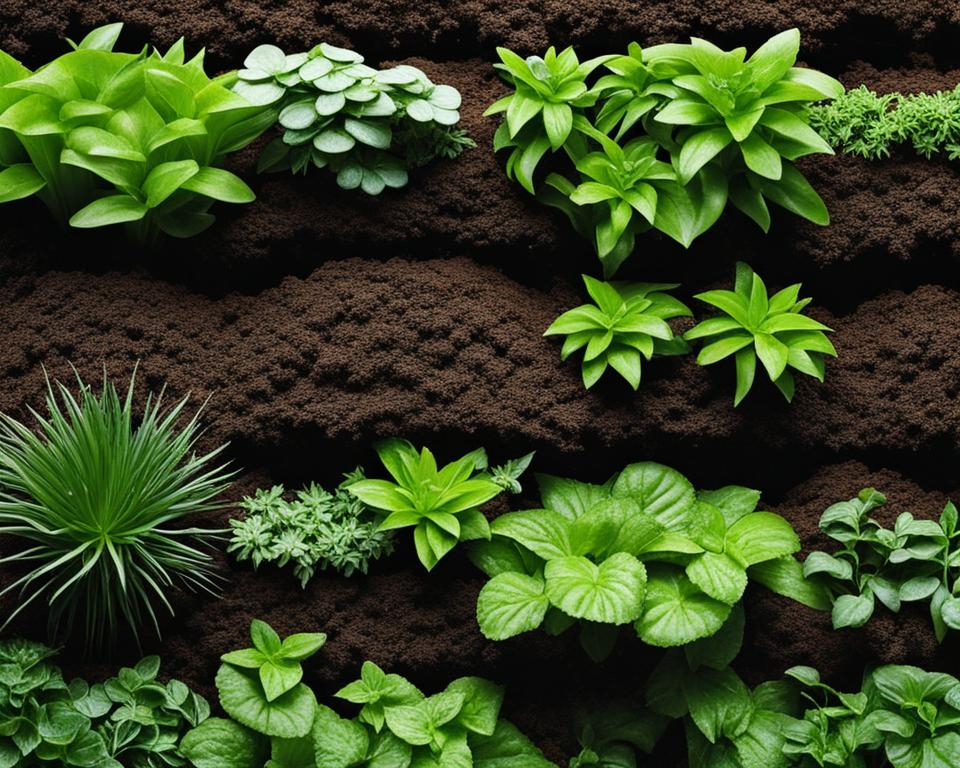
In vertical gardening, the vitality of your plants depends significantly on two critical factors: vertical gardening soil and vertical garden drainage. Understanding and optimizing these aspects can promote the health and growth of your garden, whether it’s scaling a sun-drenched balcony or a cozy indoor wall.
Choosing the Right Soil Mix for Vertical Gardens
The selection of soil for your vertical garden is not a trivial decision. A high-quality potting mix that is rich in nutrients and well-draining will accommodate the unique requirements of vertical gardening. It’s crucial to avoid soil compaction to ensure that air and water move freely to roots. This calls for a soil mix that retains moisture yet drains excess water with ease, preventing the dreaded root rot.
DIY Drainage Solutions for Healthy Roots
Expert gardeners often suggest a mix of peat, pine bark, and perlite or vermiculite as a tried-and-true recipe for vertical gardening soil. However, creating effective vertical garden drainage doesn’t stop with soil. Innovative DIY methods, such as placing a layer of rocks or gravel at the base of planters, can improve drainage. Moreover, choosing or crafting containers with appropriate drainage holes is paramount to preventing waterlogging, ensuring that your vertical garden remains a verdant and productive space.
Designing Your Vertical Garden for Visual Appeal
The allure of your vertical garden is not only in its ecological benefits and space-saving features but also in its ability to transform a plain wall or balcony into a living tapestry. A well-designed vertical garden is more than just a collection of plants; it’s a work of art that can provide a stunning focal point for your outdoor or indoor living space.
Creating Aesthetic Garden Focal Points
When designing your vertical garden, it’s essential to create focal points that will catch the eye and anchor the overall layout. These can be achieved by artfully grouping plants with striking forms or vibrant flowers, or by integrating distinct elements such as whimsical garden sculptures, water features, or bold-patterned foliage. These focal points guide the viewer’s gaze and bring a sense of harmony and intent to the design.
Incorporating Color and Texture through Plant Selection
Selecting the right combination of plants can lead to a visually delightful vertical garden that offers a feast of color and texture. Utilize plants with different leaf sizes, shapes, and textures for contrast—smooth against coarse, broad against fine. Integrate seasonal bloomers that offer a changing palette throughout the year for a garden that remains dynamic and exciting.
mix
- Statement plant with unique foliage
- Vibrant flowers for pops of color
- Feathery grasses for soft textural contrast
The thoughtful use of color and texture can elevate the overall vertical gardening design, emphasizing the vertical gardening benefits by making the garden not only productive but picturesque.
Creating Spaces That Engage and Interest
Your vertical garden should be a space that invites interaction and offers a respite from a busy world. It could include seating areas where you and your guests can be close to the natural beauty, or pathways that allow for intimate views of each plant. Integrating edible herbs and vegetables can offer an interactive experience where one can literally taste the fruits of their labor, elevating the appeal of time spent within the green oasis.
The charm of vertical gardening doesn’t stop at its space efficiency or the fresh produce it provides; it extends into the creation of an inviting atmosphere. With the use of imaginative vertical gardening design, your living green wall will not only serve its function but also enrich your quality of life with its inherent vertical gardening benefits.
Maintenance and Care: Vertical Gardening Tips
Vertical gardening brings with it a unique set of rewards and challenges, particularly when it comes to maintenance. Regular upkeep is the key to ensuring your vertical garden not only survives but thrives. Let’s delve into some vertical gardening tips and best practices for the maintenance of vertical gardens.
Watering is one of the most vital aspects of gardening, and vertical gardens require a careful approach. It’s imperative to reach each plant without over or under-watering others. A drip irrigation system can be calibrated to distribute water evenly and prevent wastage, ensuring that every plant gets its fair share of hydration. Remember, plants at the top can shield those below from moisture, so it’s important to check the soil at different levels for dryness.
Pruning is another essential task that keeps your garden looking neat and prevents the spreading of plant diseases. Since vertical gardens can sometimes be harder to reach, consider installing paths or using gardening tools with elongated handles for easier access without disturbing the plant’s natural growth.
- Inspect for pests and diseases regularly, looking under leaves and around stems.
- Prune away any dead or diseased foliage to promote healthy growth and improve air circulation.
- Monitor water distribution to ensure that each plant receives adequate moisture, especially those positioned higher up.
Mind the details when maintaining your garden; inspecting and caring for your plants ensures longevity and abundant yields. By incorporating these vertical gardening tips and dedicating time to maintenance of vertical gardens, you’re setting up your garden for success.
Seasonal Considerations and Upkeep
Adapting your vertical garden to the changing seasons is essential for maintaining a vibrant and productive space. Understanding and implementing key strategies for seasonal vertical gardening and vertical garden upkeep can greatly enhance the longevity and beauty of your outdoor or indoor living walls. Let’s delve into the specifics of keeping your vertical garden in peak condition all year round.
Preparing for Changes in Weather
As seasons shift, your green wall will face different environmental challenges. In winter, insulate containerized plants to prevent root damage from freezing temperatures. During the sweltering summer heat, consider setting up a shade cloth to protect your plants from sun scorch. Regular checks for drainage and airflow will help prevent diseases that can arise due to seasonally specific weather patterns.
Plant Rotation and Pruning
Keep your garden dynamic by practicing plant rotation; this not only prevents soil nutrient depletion but also disrupts pest and disease life cycles. Pruning is just as important in a vertical setting as it is in traditional gardening; it promotes air circulation and new growth. Timely pruning before the onset of each season helps manage plant size and health, ensuring your garden remains manageable and aesthetically pleasing.
Pest Management in a Vertical Setting
Vertical gardens can be susceptible to pest invasions; therefore, a proactive approach to pest management is crucial. Regularly inspect the undersides of leaves and between plants for early signs of infestation. Consider introducing natural predators like ladybugs or using neem oil as an organic pest control solution.
Here’s a table to guide you through season-by-season upkeep for your vertical garden:
| Season | Upkeep Tasks | Pest Management Tips |
|---|---|---|
| Spring | Prune winter damage, start seedlings, fertilize | Apply organic insecticidal soaps for early pests |
| Summer | Provide shade, mulch, increase watering regime | Introduce beneficial insects, look out for mites |
| Fall | Harvest mature plants, plant cool-weather crops | Remove fallen leaves that could harbor pests |
| Winter | Insulate roots, reduce watering, cover sensitive plants | Monitor for indoor pest issues like whiteflies |
Through diligent vertical garden upkeep, including adapting to weather changes, implementing rotation and pruning practices, and maintaining vigilant pest control, your vertical garden will not only survive but thrive in each season. Remember, a little effort in maintenance goes a long way in reaping the bountiful rewards of vertical gardening.
Conclusion
Embarking on the journey of vertical gardening unlocks a realm of creative potential, presenting an innovative method to transform any small space into a verdant oasis. Through the concise insights offered in this guide, the concept of vertical gardening is made simple, accessible to both novices and seasoned gardeners alike. The beauty of this gardening approach lies in its versatility and the spatial elegance it brings to urban settings, where space is a treasured commodity.
Your venture into the world of vertical gardening innovation does not have to be complex or overwhelming. With a mixture of careful planning, selecting the right plants, and understanding the fundamental maintenance needs, you can efficiently nurture a bountiful vertical garden. The process itself encourages a deeper connection with the natural world, offering daily engagement with living plants that thrive under your care.
Whether your aim is to cultivate an edible green wall or a floral tapestry to enhance the aesthetics of your home, the strategies presented here can guide you towards realizing your vision. The transformative power of vertical gardens invites you to experience gardening not just as a hobby but as a passionate expression of your creative touch, contributing to a greener and more sustainable environment right outside your doorstep.
FAQ
What is Vertical Gardening?
Vertical gardening is a gardening practice where you grow plants in a vertical orientation instead of spreading them out horizontally. This space-saving technique often involves using trellises, walls, or other vertical structures to support the plants. It’s an effective method for small spaces and can add aesthetic interest to your garden.
How can vertical gardening improve my space efficiency and aesthetics?
Vertical gardening can turn underutilized vertical spaces into productive areas, allowing you to grow more plants in a limited footprint. It also adds a new dimension of beauty to your environment, as the vertical elements can be used to create visually striking living walls and garden features.
What are the benefits of healthier plants and convenient harvesting in vertical gardening?
Growing plants vertically can lead to healthier plants as they have better air circulation, less soil disease transmission, and reduced pest infestations. Plus, vertical gardening can make harvesting easier as fruits and vegetables are within arm’s reach, reducing the need for bending and kneeling.
Does vertical gardening have a positive environmental impact?
Yes, vertical gardening can have a positive impact on the environment. It makes efficient use of space and resources, can contribute to urban greening, reduce heat islands, improve air quality, and support biodiversity by providing habitats for various insects and birds.
How do I plan my DIY vertical garden?
Start by assessing your available space, sunlight, soil conditions, and personal design preferences. Identify suitable plants and structures that fit your space’s dimensions and conditions. Plan how to install these structures to create your own vertical garden tailored to your needs.
What plants are suitable for vertical gardening in small spaces?
Climbing vegetables like cucumbers, beans, tomatoes, and peas are great for small space vertical gardening. You can also include vining flowers or trailing ornamentals like ivy and petunias to beautify the space and utilize vertical areas effectively.
How do I choose the right structures for my vertical garden?
Consider the types of plants you want to grow, their weight, and how you want your garden to look. Options range from wooden trellises, metal supports, hanging baskets, to wall-mounted planters. Choose structures that will support the growth and size of your plants, as well as fit the aesthetic of your space.
Can I create a vertical gardening system on a budget?
Absolutely. You can build DIY garden trellises out of bamboo, wooden stakes, or even upcycle items like pallets and old furniture. It’s a cost-effective way to get creative with your garden design while saving money.
How do I construct DIY arched garden trellises?
To build a DIY arched trellis, you can use flexible materials like cattle panels or PVC pipes anchored into the ground with sturdy stakes. The arch shape creates a strong structure for plants to climb and can be a stunning feature in your garden.
What are some simple and affordable vertical supports I can use?
Easy and inexpensive vertical supports include nylon netting, twine strung between posts, and re-purposed items like old ladders. These materials can be easily configured to fit your space and the needs of your plants.
How can I ensure proper drainage and soil quality in my vertical garden?
Use a high-quality potting mix designed for good drainage and consider adding a layer of gravel or rocks at the bottom of containers or planters. Make sure there are adequate drainage holes in any vertical planting system.
How should I design my vertical garden for visual appeal?
Use a mix of plants with varying colors, shapes, and textures to create interesting visual patterns. You can also arrange plants to create focal points, and coordinate plant selection with structural materials for a cohesive look.
What maintenance and care tips are important for vertical gardens?
Regularly water, prune, and check your vertical garden for pests. Due to their setup, vertical gardens may dry out more quickly, so monitoring moisture levels is crucial. Also, ensure easy access for these maintenance tasks to keep your garden thriving.
What seasonal considerations should I keep in mind for my vertical garden?
Prepare for cold weather by insulating plant roots, and in hot weather, consider shading your plants. Rotate crops as needed and prune regularly to encourage new growth. Stay vigilant about pest control, especially since vertical gardens can be more susceptible to infestations.

